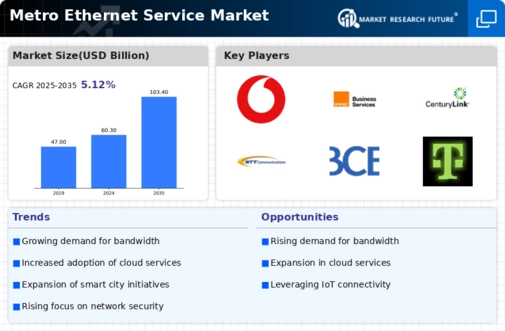The Metro Ethernet Service Market has become increasingly competitive as businesses and organizations seek reliable, high-speed connectivity solutions. This market is characterized by several key players who are innovating and expanding their service offerings to cater to the ever-evolving demands of enterprises looking for enhanced bandwidth and connectivity. With the proliferation of cloud computing, Internet of Things (IoT), and data-intensive applications, the need for Metro Ethernet services is on the rise.
Companies in this sector are constantly adapting their strategies, including enhancements in service quality, the expansion of their geographic reach, and the introduction of new service features, to differentiate themselves and capture a larger share of the market. Collaboration with technology partners, investment in advanced infrastructure, and a focus on customer service are among the critical strategies being employed across competitive entities in this dynamic environment.
Vodafone has carved a significant presence within the Metro Ethernet Service Market, leveraging its extensive network infrastructure and technological capabilities. The company has established itself as a strong competitor through the provision of scalable and flexible Ethernet solutions that cater to diverse customer needs. With an emphasis on providing businesses with secure, high-capacity connections, Vodafone's Metro Ethernet services are designed to facilitate seamless communication and data transfer. Its global footprint enables Vodafone to support multinational corporations effectively, ensuring that clients have reliable connectivity across various locations.
The company's commitment to innovation and customer satisfaction strengthens its position in the market, enabling it to respond swiftly to evolving demands and maintain a competitive edge.
Orange Business Services, as a key player in the Metro Ethernet Service Market, focuses on delivering comprehensive, secure, and high-performance networking solutions to businesses worldwide. The company stands out due to its robust service portfolio, which includes tailored Ethernet solutions designed to meet the specific requirements of organizations across different sectors. Orange Business Services capitalizes on its extensive experience and technological expertise, providing clients with scalable solutions that adapt to their changing connectivity needs. The company's investment in state-of-the-art infrastructure and commitment to advancing its service offerings ensures that businesses benefit from fast, reliable connectivity.
Furthermore, Orange Business Services' strong emphasis on customer engagement and support distinguishes it from competitors, fostering lasting customer relationships and enhancing overall customer satisfaction in the competitive landscape of the Metro Ethernet service market.













